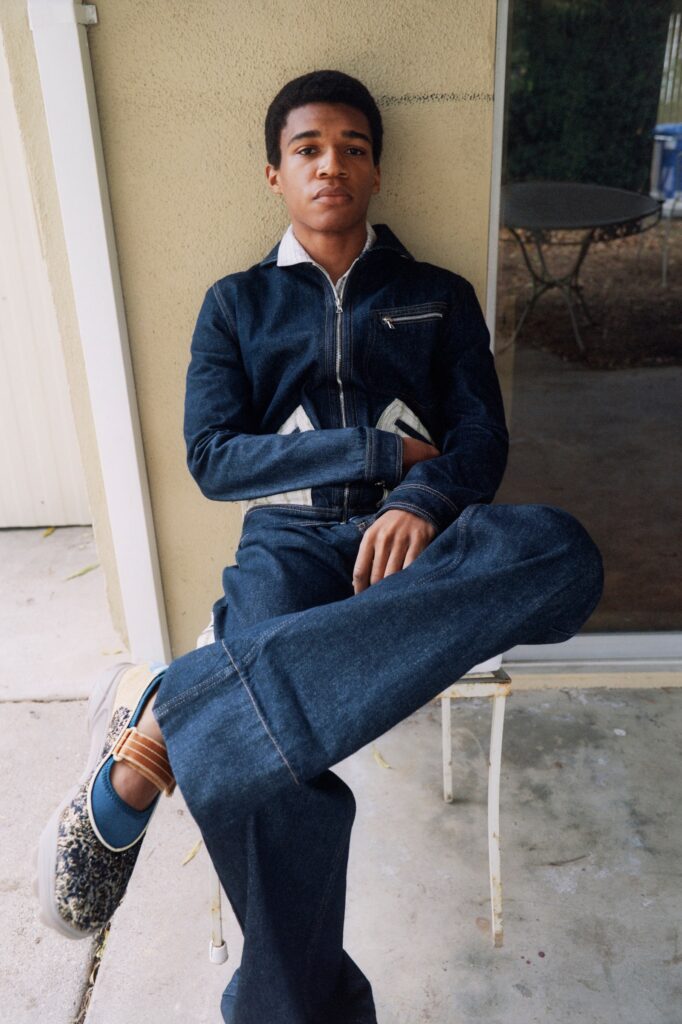Shared from Culture
When I caught up with the British menswear designer Grace Wales Bonner late last month, she was feeling zen and looking as elegant as ever, with a pair of Jil Sander freshwater pearls hanging in her ears. Wales Bonner has always been a calm and collected sophisticate hovering above a manic industry, but on this day she radiated a new unflappability. Each of her collections is the result of several collaborations with artists, photographers, musicians, and others in her creative circle. That approach hasn’t changed drastically since I first wrote about her work in 2019, she said, but “what’s been nice since that time is that I’ve been able to have ongoing relationships and partnerships and interactions with people.” Steven Traylor, who made a film for the collection, also worked with Wales Bonner on her edition of A Magazine Curated By, which came out in January, as did photographer Zoe Ghertner, who shot the collection’s lookbook. The artist Paul Sepuya is regularly in the Wales Bonner mix, too, sometimes as a fellow creator and other times just spiritually. Collaboration is frequently used to spark a new idea that’s limited and ephemeral, but Wales Bonner’s approach struck me as an unusually mature way to think about making clothes.
That collection was more playful, more casual than ones in the recent past, but it felt as though Wales Bonner was really designing as an adult—making work that can only be shaped by deep and lasting friendships and continued conversations, by long dinners and meanders through museums and group texts about gallery shows and old photographs. Even her approach to Adidas, with whom she began a partnership in 2020, has a gracefulness to it. The shoe used throughout this collection—a Mary Jane with a built-in sock that will be just as popular, if not moreso, than her crocheted Samba—is crisp, low-key.
Fashion has become a playground and even a mandate for the very young. But as my conversation with Wales Bonner (and a powerful Prada show at the outset of fashion month) reminded me, there are great joys to be had for the much older—or just thirty- and forty-somethings who feel disconnected from the relentless churn of trends being pursued by Gen-Z. It isn’t that we are ready to abandon sweatpants; it’s that we’re ready to wear them in a more evolved way. Classic coats and luxed up separates now abound in stores like Noah and Aime Leon Dore—I was particularly bowled over by a herringbone cape from the former—and suggest that a sharp suit isn’t the only route to dressing with a bit more intention or refinement.
Even aging itself seems appealing. Over the past year, the work of designers like like Paul Harnden and John Alexander Skleton, who use techniques and materials of the late 19th century, seem more intriguing—not urgent, which slow fashion never is, but something to aspire to, and even kind of bad-ass with a pair of track pants. Skelton, who doesn’t often stage fashion shows, was a highlight of the month for the utter strangeness of his old men trudging through a dark crypt underneath the London streets. And after a year or so of dabbling in hypebeast nation, Yohji Yamamoto’s clothes took on a similarly antiqued tone. Of course, semi-historical dressing isn’t necessarily about maturity, but the age range of Yamamoto’s cast, and the way the clothing hung on their shoulders, made it so cool. Coolness is now considered the province of the very young—people who discover Lucien on TikTok or whatever—but coolness is really something you acquire through years of honing your taste and experience. And experience is what gives a person’s clothing character.
A few years ago, a writer named Linda Przybyszewski published The Lost Art of Dress, which argued that women’s fashion, which was once intended for those over 40, had shifted to cater to the young, beginning in the ’60s and accelerating in the 2000s. Przybyszewski’s idea was that this was a bad thing: there were certain colors and silhouettes and designers that a younger woman couldn’t pull off or understand; she needed to enter a period of authority and maturity in order to wear something like a tent-shaped dress in silk shantung by Cristobal Balenciaga, let alone afford it. That argument still fascinates me as a framing for womenswear, but for men’s, the story is more complicated. Older men, particularly Roger Stone-types with a blind allegiance to rules and outdated styles, like to mock the clothes of the young, but older guys often look silly trying to wear the clothes that everyone else in the world is actually talking about.
Recently, I spoke to Casablanca designer Charaf Tajer about that viral photo of Jeff Bezos wearing one of his silk shirts on New Year’s Eve. “It’s interesting, he is the richest man in the world, so there is a kind of Lex Luthor feel to it,” Tajer said, adding that “I found it quite ‘internet moment.’” The problem was less the pattern (terrific) or material (silk) than the fit (way, way too tight). Loosen it up and he might have looked fabulous. Tajer’s clothing, after all, borrows heavily from the older Moroccan men who dress with a sensual panache—dressers who are confident, flashy, full of personality, and best of all, old.
Images and Article from Culture

